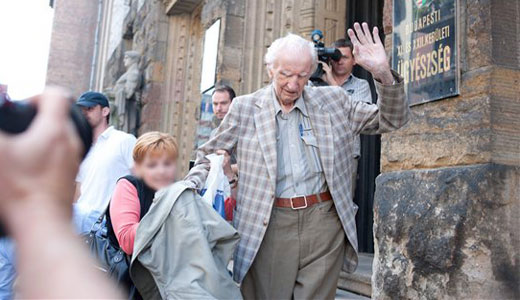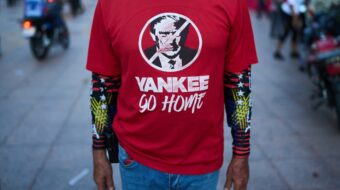
A 97 year old former Hungarian police official, Laszlo Csizsik-Csatary, was arrested in Budapest last week at the urging of the Wiesenthal Center, and will be tried for crimes committed against the Jewish population of Kosiče, Slovakia, during the Second World War. This case has importance far beyond the issue of one man’s guilt or innocence.
Kosiče, called Kassa when it was part of Hungary, had an ethnic composition including many Magyars (ethnic Hungarians), with large Slovak and German minorities and a thriving Jewish community. In 1919, after the end of the First World War and the collapse of the Austro-Hungarian Empire, Kosiče and its surrounding region were awarded to the newly formed Republic of Czechoslovakia by the Treaty of Trianon, which also awarded big pieces of Hungary to Romania and Yugoslavia. Trianon left a third of the Magyar people outside Hungary’s borders, and fomented the same kinds of resentments in Hungary that the related Versailles treaty did in Germany.
After the fall of a short-lived communist government, Hungary fell under the control of increasingly repressive right wing governments. In place of the deposed king, Admiral Miklos Horthy became “regent.” Horthy was served by a series of prime ministers who suppressed the Communist Party and made sure that the interests of the ruling class-both the old landholding aristocracy and the financial and industrial bourgeoisie-were not disturbed.
Over time, overtly fascist tendencies increased their power, especially in the military and the Gendarmie, or national police, in which Csatary served as an officer. A line was crossed in 1932, when Horthy appointed as Prime Minister Gyula Gömbös, a personal friend, an out-and-out fascist and extreme anti-Semite.
After Gömbös died in 1936, more anti-Semitic and fascist-tinged politicians ended up heading the cabinet, all appointed by Horthy: Kalman Daranyi from 1936 to 1938, Bela Imredy from 1938 to 1939 and Laszlo Bardossy from 1941 to 1942 (between Imredy and Bardossy came Count Pal Teleki, no progressive but who committed suicide when he could not stop Germany from moving troops through Hungary to invade Yugoslavia).
These gentlemen upped the agitation against Jews in Hungary, and also began to enmesh Hungary more and more with Nazi Germany, eventually declaring war on the Soviet Union (using a mysterious bombing of Kosiče as a pretext) and sending Hungarian troops to die alongside the Germans on the Eastern Front.
One motive for allying Hungary with Hitler was to get German support for reversing the land concessions of Trianon. In the First Vienna Award of 1938, German intervention resulted in the return of southern Slovakia, including the city of Kosiče, now Kassa again, to Hungary. Laszlo Csizsik-Csatary was made commander of the Gendermie in Kosiče/Kassa in 1941.
In March of 1942, Admiral Horthy removed his pro-Nazi prime minister, Bardossy, and replaced him with Miklos Kallay whose mission was to find a way for Hungary to disentangle itself from the German alliance the war.
Hitler got wind of this, and, in March 1944, occupied Hungary and forced Horthy to remove Kallay and replace him with a virulent Nazi, Dome Sztojay. Briefly a general, Geza Lakatos, replaced Sztojay and returned to the efforts to find a peaceful exit from the war, at which point Hitler had Horthy, Kallay and others imprisoned, and imposed the leader of the Nazi Arrow Cross Party, Ferenc Szalasi, as leader, in October 1944. Szalasi was ousted by the conquest of Hungary by the Soviet Red Army.
Why are all these names and dates important? Because in Hungary today, the right wing government of Prime Minister Victor Orban of the Fidesz Party, and also the neo-fascist and viciously anti-Semitic Jobbik Party, are engaged in a campaign for the whitewashing of Horthy.
One claim is that Horthy was the protector of the Hungarian Jews during the Second World War. It is true that Horthy opposed the mass deportation of the longstanding Jewish population of Budapest to death at Auschwitz. But there is plenty of evidence of his personal anti-Semitism.
“National Army” forces he led in 1919 committed many anti-Semitic outrages. He cheerfully signed off on a whole series of anti-Jewish laws. In the territories, including Kosiče, that Hungary got back by the First and Second Vienna Awards, Jewish refugees from other countries, and Hungarian Jews who could not prove their citizenship, were violently expelled.
Csizsik-Csatary’s tenure in Kosiče began in 1941, while the biggest deportation of the city’s Jews to Auschwitz, involving the extermination of 15,700 persons, happened in 1944, when the Germans were running the show. But Csizsik-Csatary is also accused of culpability in the Kamenetz-Podolsky massacre in 1941, in which Jews deported from Kosiče were massacred along with many others. At that time, Horthy and Bardossy were in full control.
So what precisely happened between 1941 and 1944 is important for the evaluation of the claim that Horthy was the “protector” of the Jews. And this 97-year-old former police commander was there, and can tell us.
Photo: Laszlo Csizsik-Csatary










